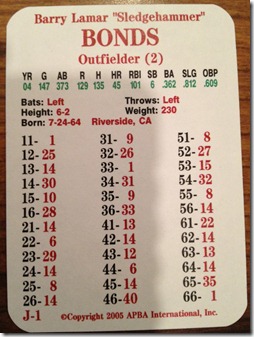APBA Blog reader Jim Shaw wrote me recently about my selection of Monster Cards. Essentially, he said, “I suggest something other than pitchers’ cards for the above as are a small sample size”.
Fair enough. Though the idea for the Monster Card series, was to get the most outlandish and fantastic “cards” out there and show them off, not necessarily the best “players”. Occasionally, the twain shall meet, however as in this in this week’s case.
To say that the 2004 Barry Bonds card (which I found on the APBA Games FB fan page recently) is based on 373 at-bats is misleading. True, but misleading. That’s because in 2004, he had 232 bases on balls for a total of 617 plate appearances. I’m sure it left the card makers at APBA with a dilemma since of those 232 walks, over half of them (120) were intentional. I remember that season. That year, teams were intentionally walking Bonds out of fear, retribution, and possible resentment . After a while though, I think they were doing it just because it was the “thing to do”.
As a result, Bonds 2004 card was given nine 14s. If my APBA math is correct, the Company gave Bonds credit for maybe 1/3 of a 14 for every intentional walk he received. Which as you can see, is still pretty amazing.
| Split | G | PA | AB | R | H | 2B | 3B | HR | RBI | SB | CS | BB | SO | |||
|---|---|---|---|---|---|---|---|---|---|---|---|---|---|---|---|---|
| 2004 Totals | 147 | 617 | 373 | 129 | 135 | 27 | 3 | 45 | 101 | 6 | 1 | 232 | 41 | .362 | .609 | .812 |
I still haven’t even addressed Barry Bonds’ power, the perceived reason he got those IBBs (though you all may have your opinions on that). For his 45 homers and 75 overall extra base hits, he received a pretty yummy 1-1-1-6-6 (look out with a runner on third!). With his six steals, Bonds even warranted a 15-10.
As a result, against a Grade A pitcher, Bonds would get on base an automatic 15 times out of 36 results not counting any error numbers. Not bad.
One final point on Bonds’ 2004 card. His real life batting average of .362 may be one of the highest of any APBA card to get a 55-8. Of course, the nine 14s make a huge difference. Using my Quick and Dirty method of determining a batting average of an APBA card, I estimate that it should bat around .367, pretty close to his real life average.
Imagine that… I got through a Barry Bonds article without mentioning the ‘S-word’.





“I suggest something other than pitchers’ cards for the above as are a small sample size”.
Speaking of ‘sample size’, here’s Barry Bonds.
He should have two more walks on his card- just saying. Why ApBA doesn’t take into account intentional walks is perplexing to me. her’s what this card did in the Illowa league.
AB R H 2B 3B HR
373 96 127 30 0 36
RBI BB SO SB AVE
73 100 47 2 .340
SLG OBP
.710 .480
Good but not great.
Cluke, must have been poor motivation from his manager ;-)
I actually told Chuck (CLuke, above, Barry’s manager) before that Illowa League season that Bonds didn’t have enough “juice” (pun intended) on his card. To me, he should have had either 2 more walks or 55-7.
I would think intentional walks are disregarded on the assumption that the player will make his or her own decision about when to walk Mr. Potato Head. If the # included his intentional walks and the player also intentionally walked him at a pace anywhere near the historic level his results would be skewed. I think the same would apply in BBW for manually played games. I don’t know how the micromanagers would respond.
Bob, that was always my assumption too.
APBA must have made an exception in 2004 Bonds’ case since he did get a couple more 14s than his unintentional walks would warrant.
Bob,
I understand the assumption about intentional walks but since the card is intended to replicate his stats- I think that most replayers or league members usually under-use the intentional walk.
Therfore, if I was to replay the year, I would want to see all walks “baked in” if you will. Much like the Herb Washington card in the 70’s, the number of intentional walks
given to bonds that year will never be approached again